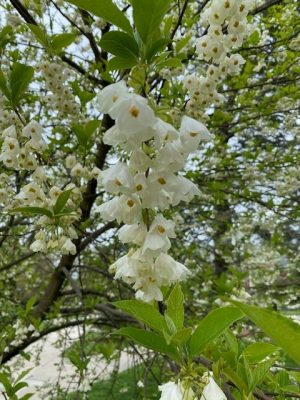By Dawn Pettinelli, UConn Home & Garden Education Center
If there’s a spot for a spring flowering tree in your landscape, now is the time to look at the trees showing off their floral splendor. Do you find one or two particularly appealing. Take note of the various flower colors, tree shapes and sizes. Once you’ve selected an alluring flowering tree or two, do a bit of homework.
Many of the spring flowering trees have several cultivars and they may vary in flower color, leaf variegation, mature height and width, fall color and so on. Pick the one that fits your location. Will the plant be in sun or shade? Is it going to be positioned as a specimen tree or incorporated into a foundation planting or a border? Will it add multi-season interest with attractive foliage, fruits or seed pods, or interesting bark? What insect or disease problems is it prone to?

Redbuds (Cercis canadensis) are bursting with blossoms right now, at least on the Storrs campus. The extremely abundant, purple-pink peas shaped blossoms practically cover the tree. At maturity, trees reach about 20 to 30 feet tall with a slightly larger width, ending up in a roundish shape with a flatter top. After flowering, heart-shaped leaves develop while faded blossoms give birth to small, flattened legume seed pods that contrast nicely with the plant’s dark, scaly bark. Cultivars are available with white or more true pink flowers, variegated foliage, weeping forms and attractive fall foliage colors. Redbuds tolerate full to part sun and well-drained soil but avoid hot, dry locations for best establishment and flowering.
Dogwoods are a favorite of many. Their pink, white or red colored bracts dazzle especially in filtered sunlight. Dogwoods are native to the eastern and central United States where they are usually found as an understory tree. Most cultivars grow to about 30 feet in height with about the same width at maturity. The large 4-inch blossoms mature to form shiny red fruit much loved by birds. These exceptionally beautiful plants favor a cool, moist, acidic soil with adequate amounts of organic matter. Dogwoods struggle when faced with heat stress, drought, and pollutants so site carefully.
Another flowering tree that also does best in more natural settings, especially those with moist soils is our native shadbush or serviceberry (Amelancher canadensis). The name, shadbush, comes from the fact that this plant typically blooms when the shad return to fresh water to spawn, usually right about now. This plant can be grown as a single stemmed specimen or a multi-stemmed large shrub. Mature trees reach about 20 feet in height but there are shorter, more shrub-like cultivars. Shadbush sports white flowers in 2-to-3-inch racemes. Dark fruits are attractive to many animals plus both the gold autumn foliage and gray bark are very attractive.

A standout for me this time of year is Carolina silverbells (Halesia carolina). A multitude of white, bell-shaped blooms adorn the branches of this 20-to-40-foot tree. Although it is native to southeast U.S., it is hardy to zone 5. Autumn color is not notable, but the tan 4-winged fruit persist well into the winter and stand out against the stark winter landscape and silvery grey bark. Be sure to check out ‘UConn Wedding Bells’, a very floriferous cultivar discovered by UConn Plant Science professor, Dr. Mark Brand. It has a smaller, rounder form with flowers larger than the species.
The star magnolia (M. stellata), as its Latin name implies, is definitely a stellar landscape plant. Gorgeous, lightly fragrant 3-to-4-inch blossoms grace the dense cluster of stems. Mature plants reach up to about 20 feet with a slightly narrower width. Plants do produce red fruits but most drop before they mature. I was delighted to find a seedling after I lost the parent tree in that late October snowstorm we had a number of years ago.
Other worthy spring flowering trees to consider include the flowering crabapples and cherries that have many exciting and lovely cultivars. A great place for information on woody plants is the UConn Plant Database (www.plantdatabase.uconn.edu). If you need more information on selecting a tree or any plant for your landscape or on other gardening topics, feel free to contact us, toll-free, at the UConn Home & Garden Education Center at (877) 486-6271, visit our website at www.homegarden.cahnr.uconn.edu or contact your local Cooperative Extension center.